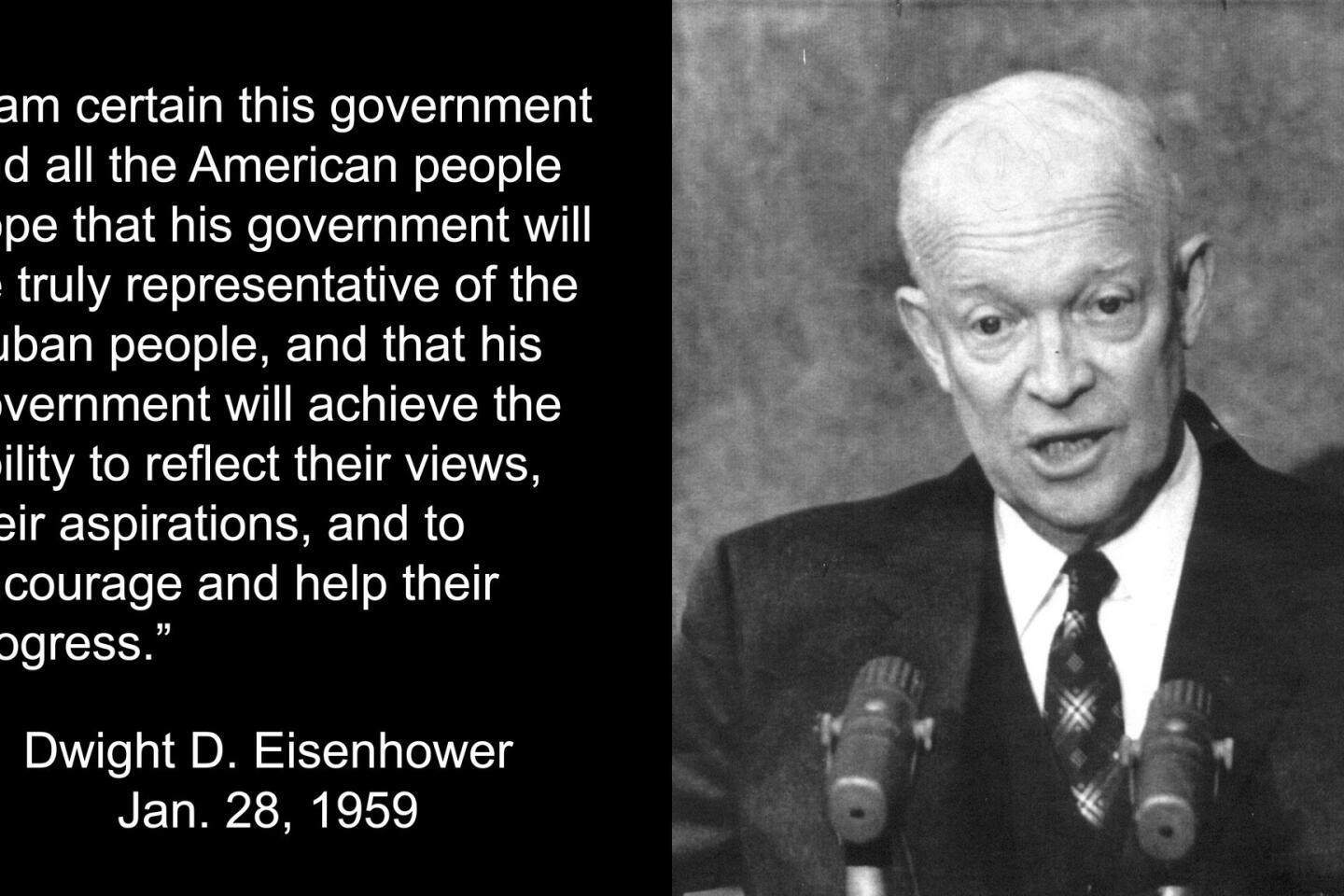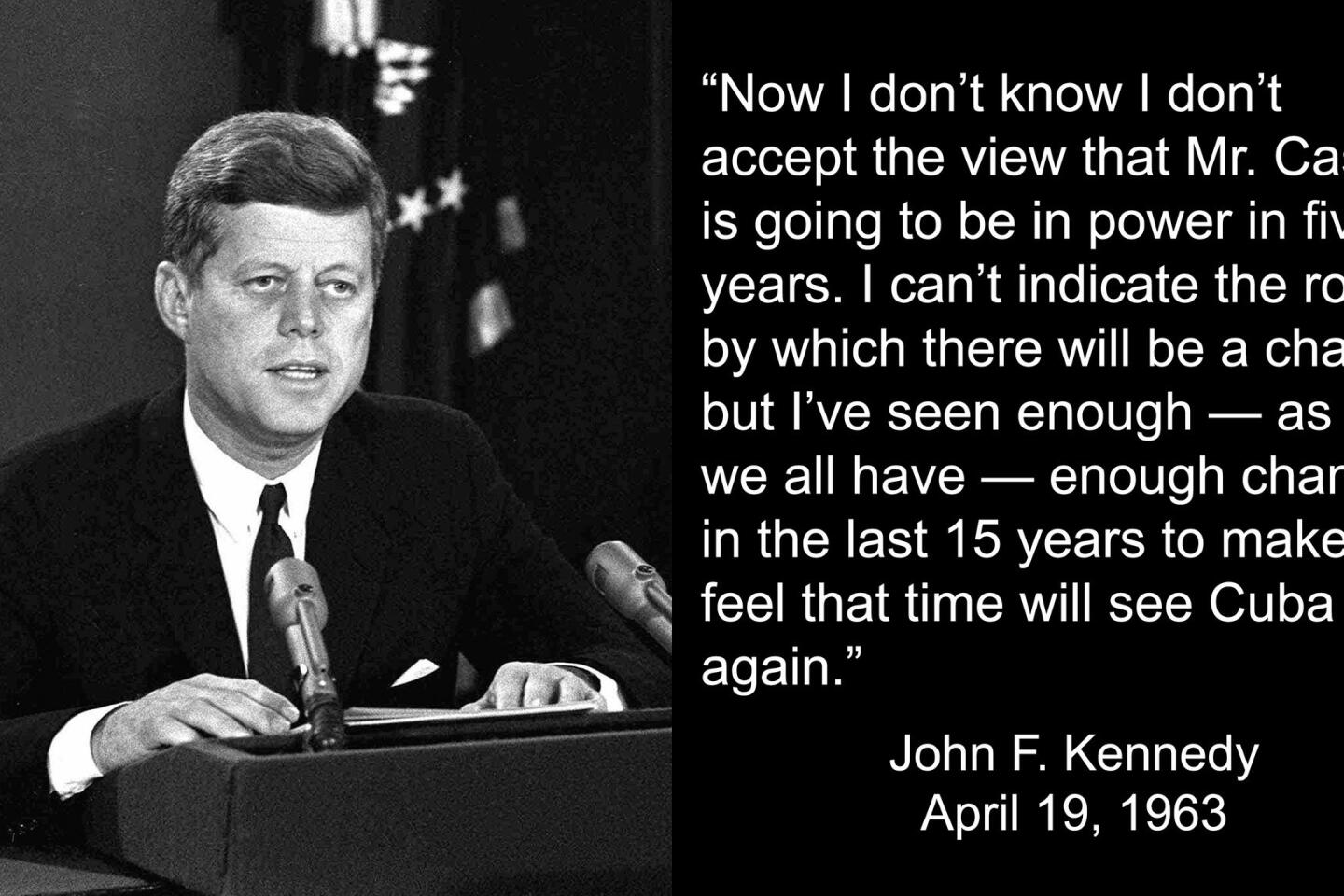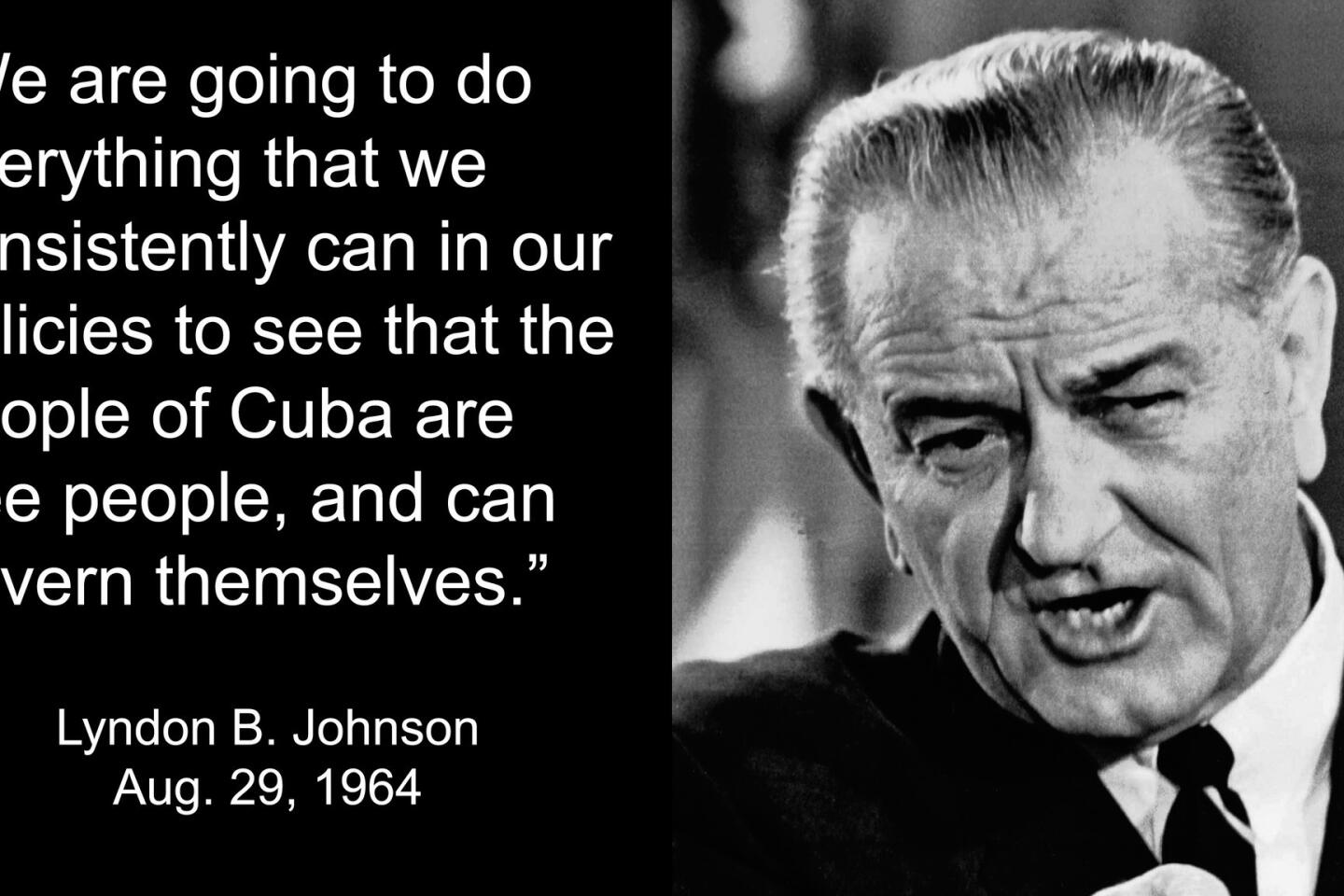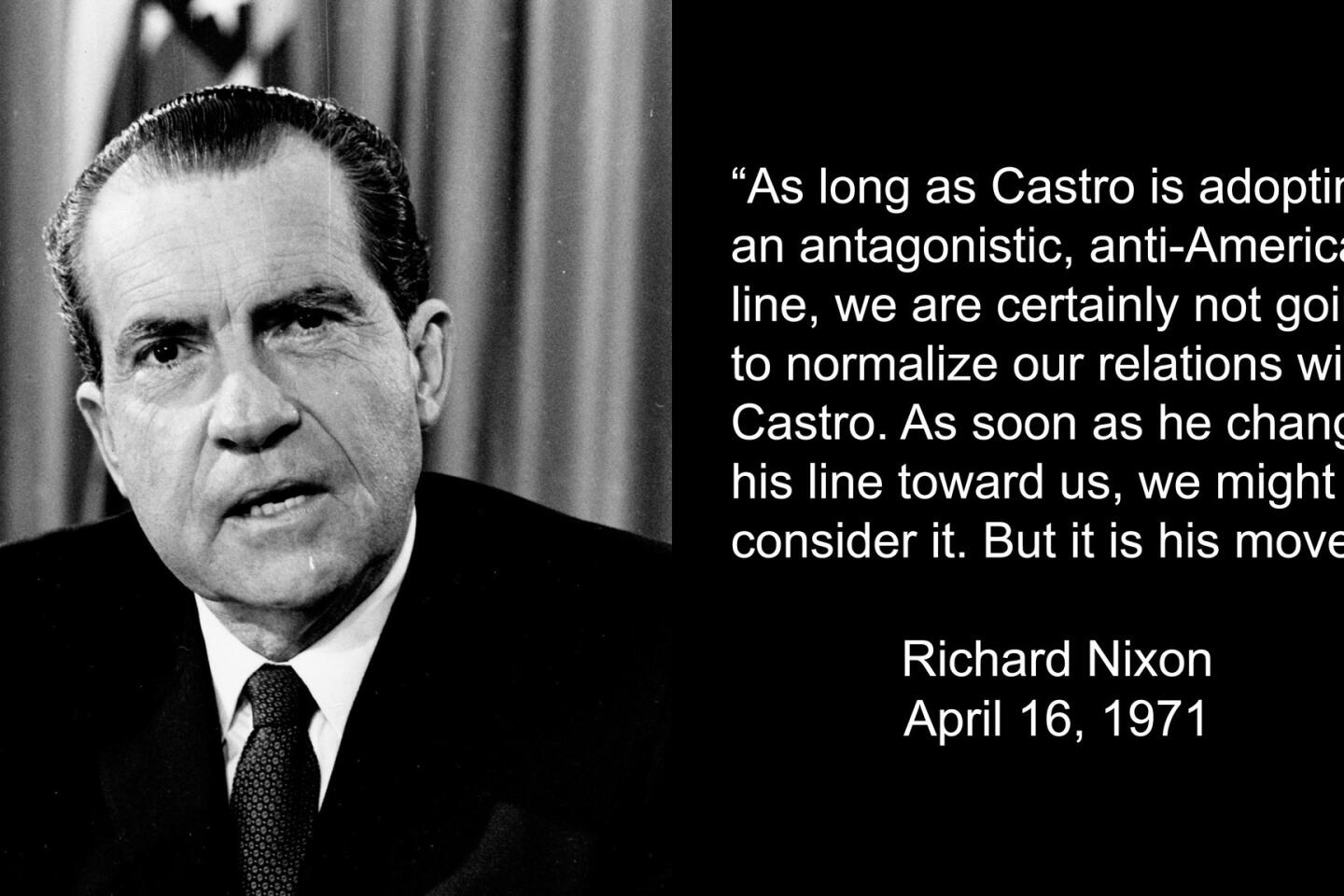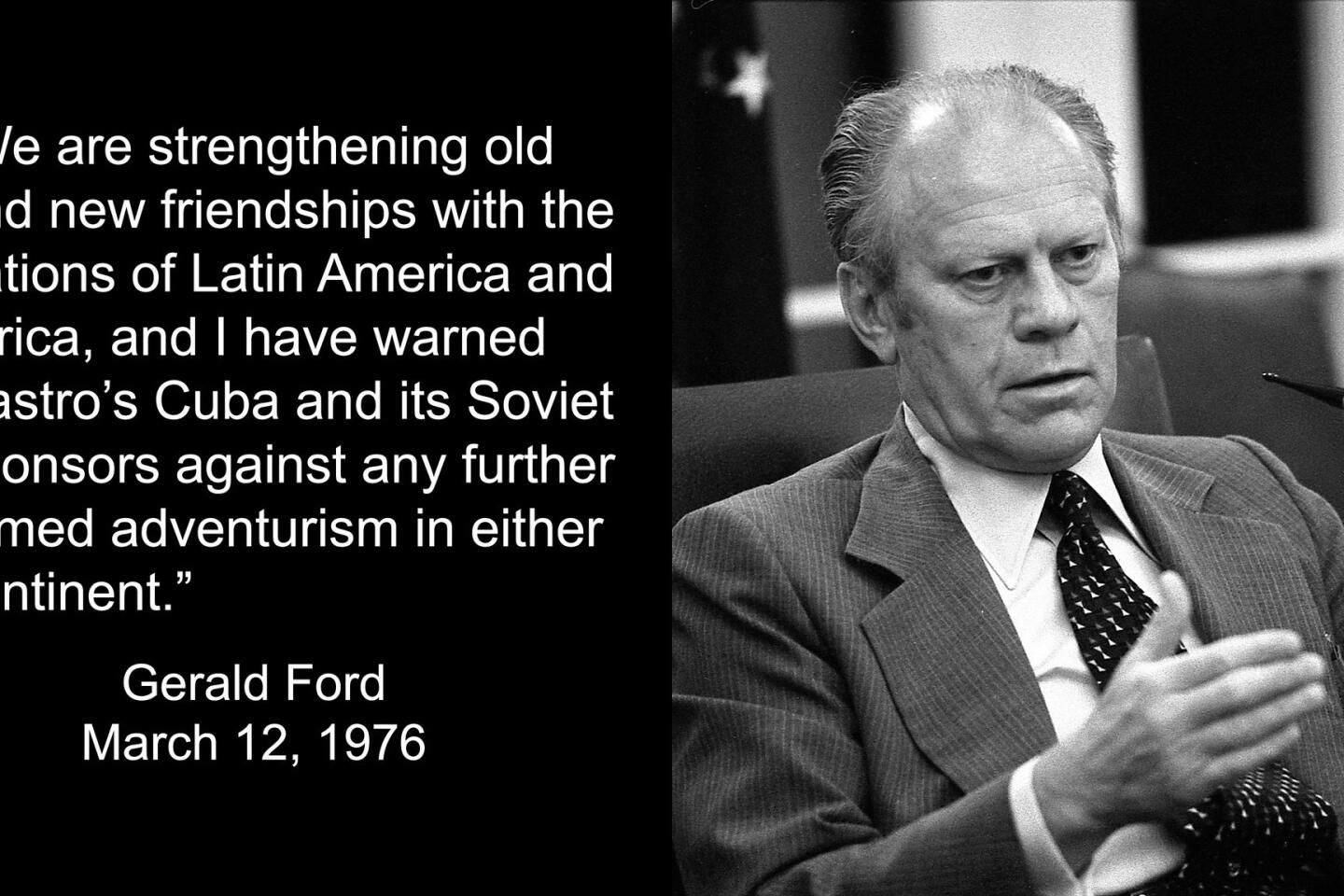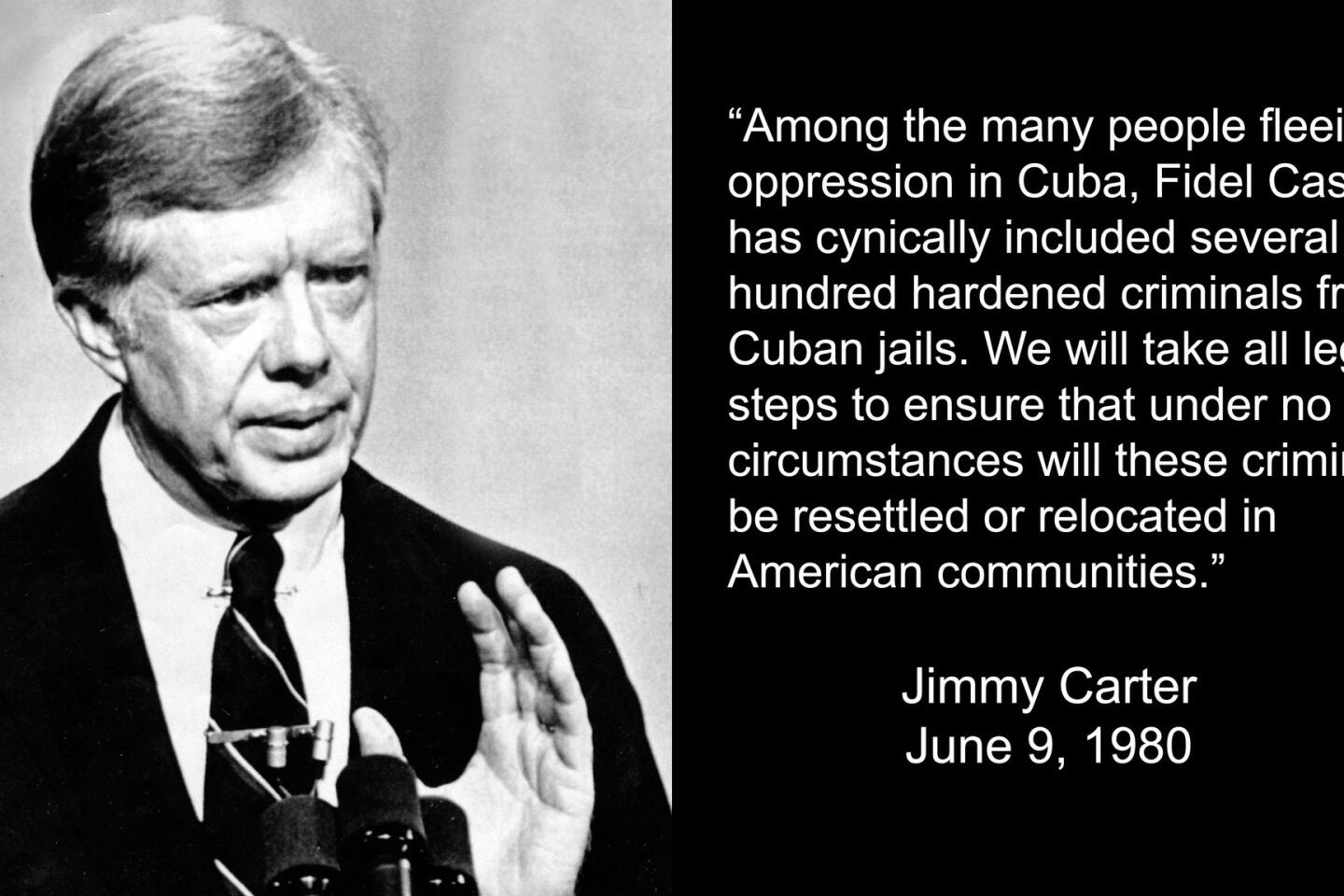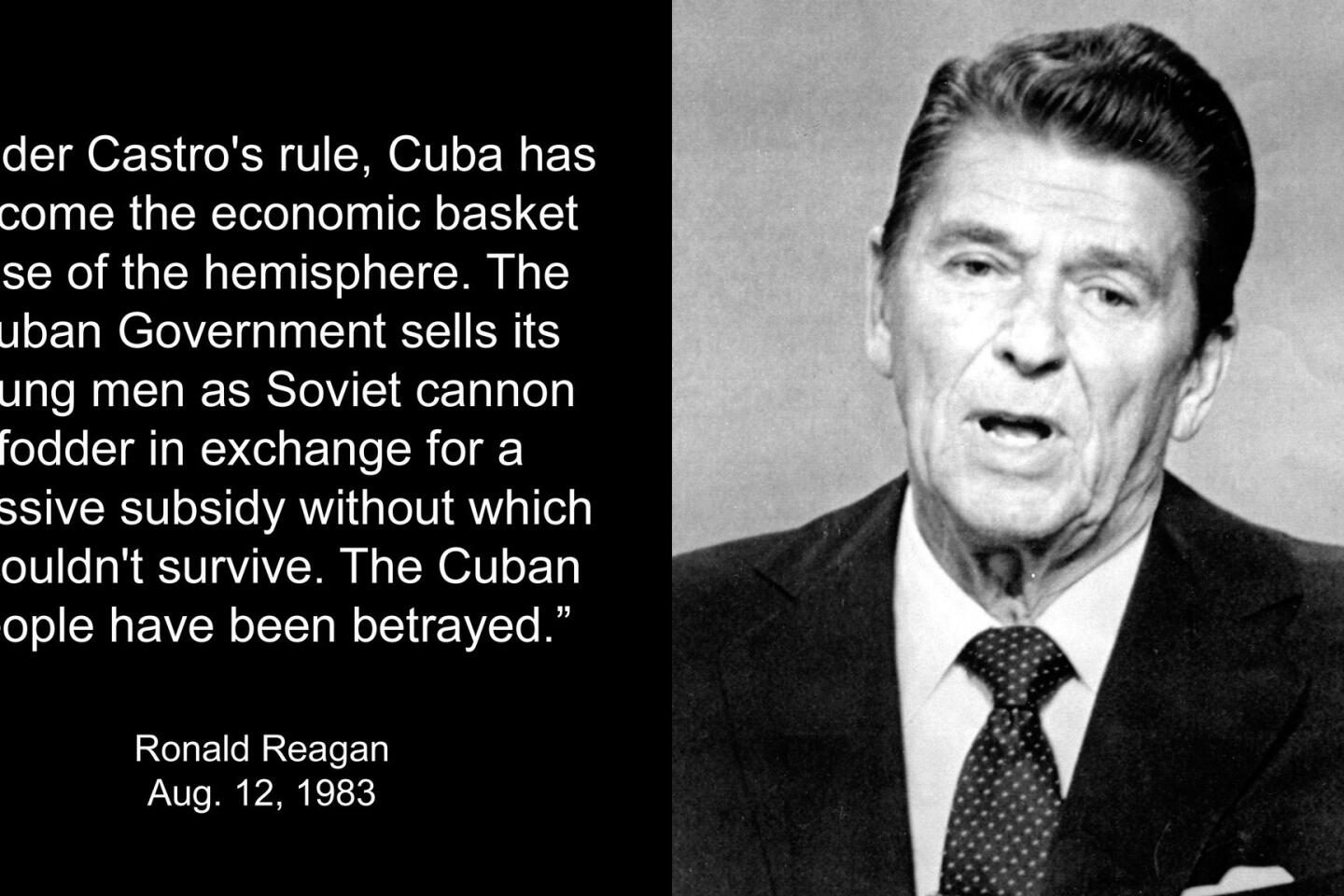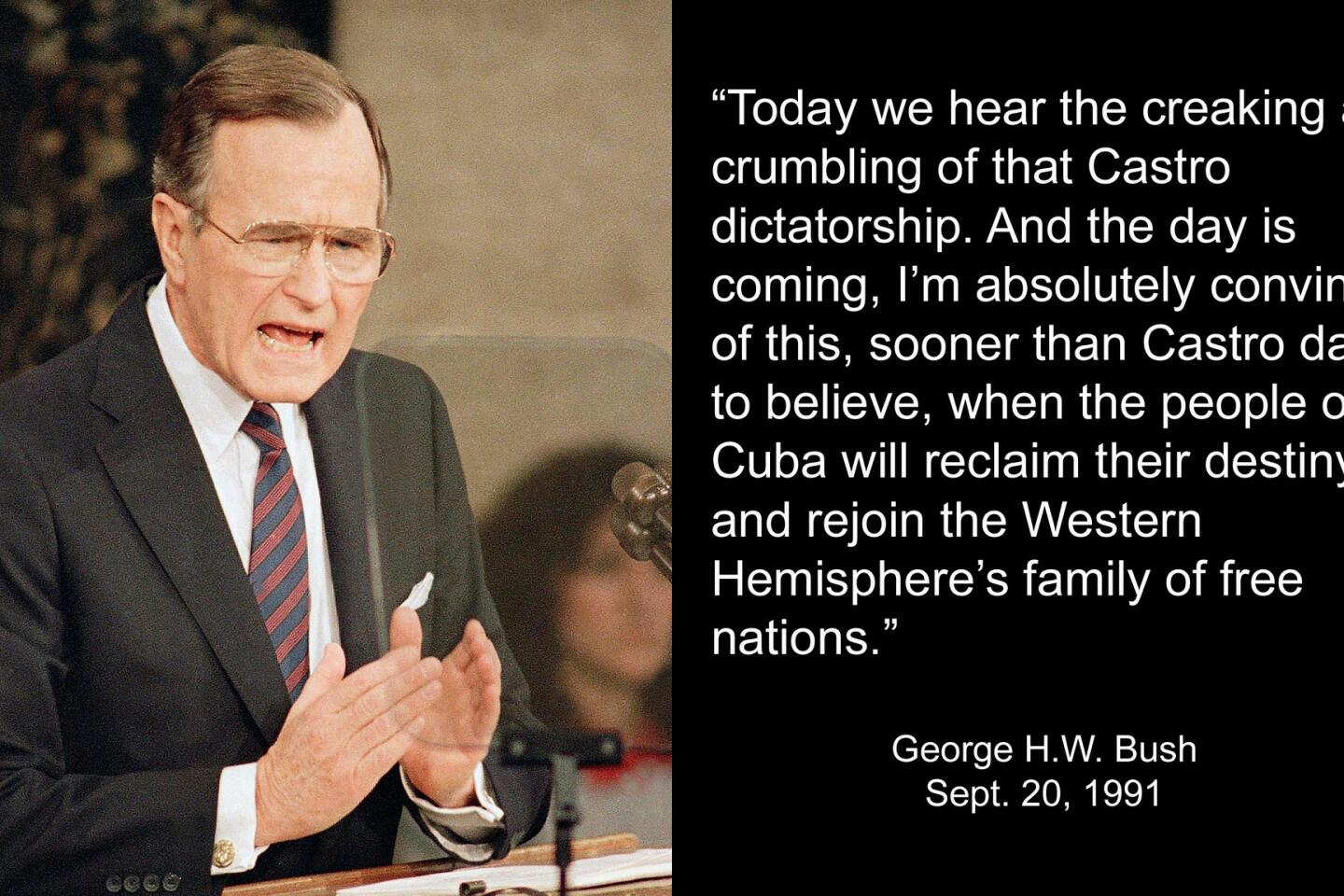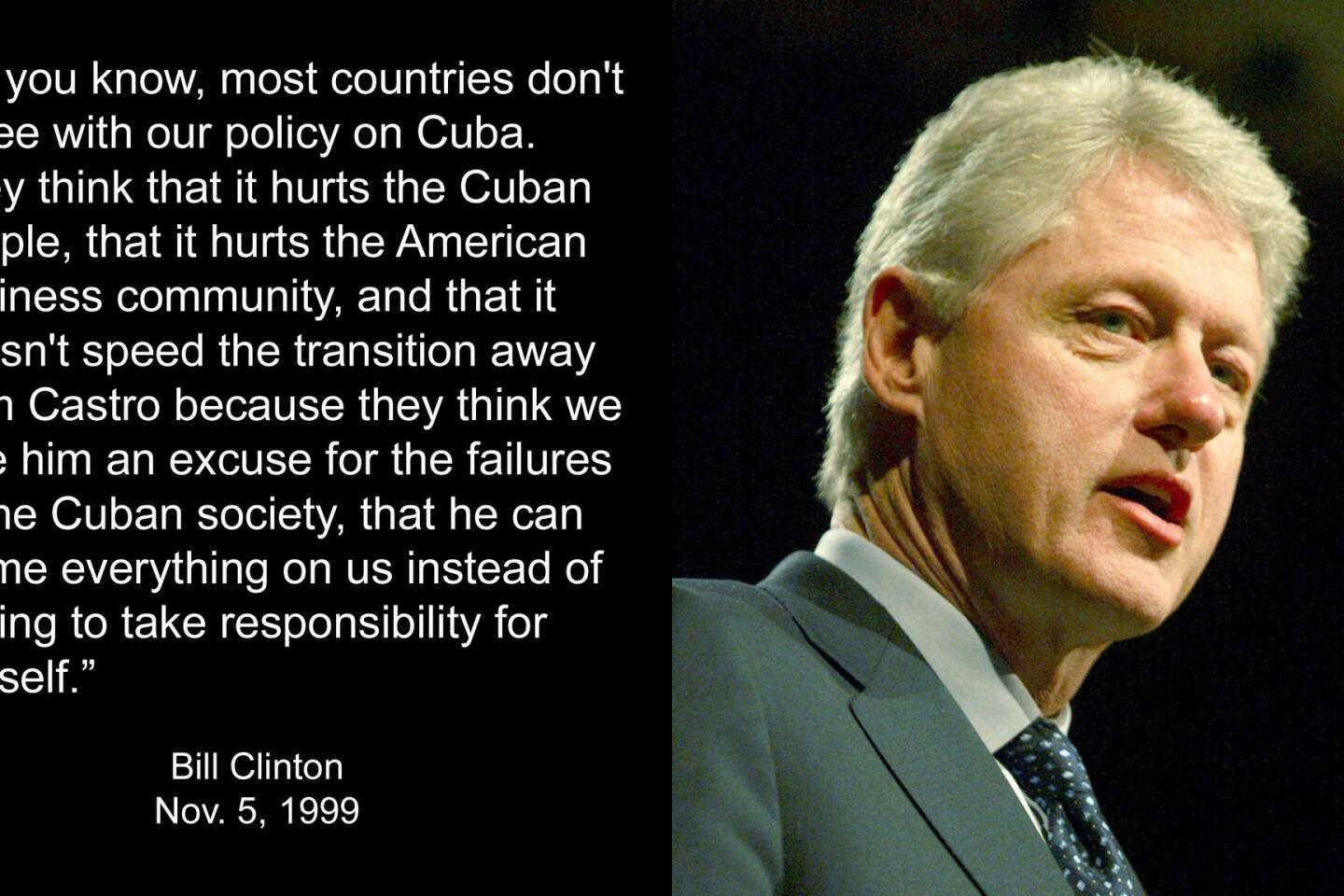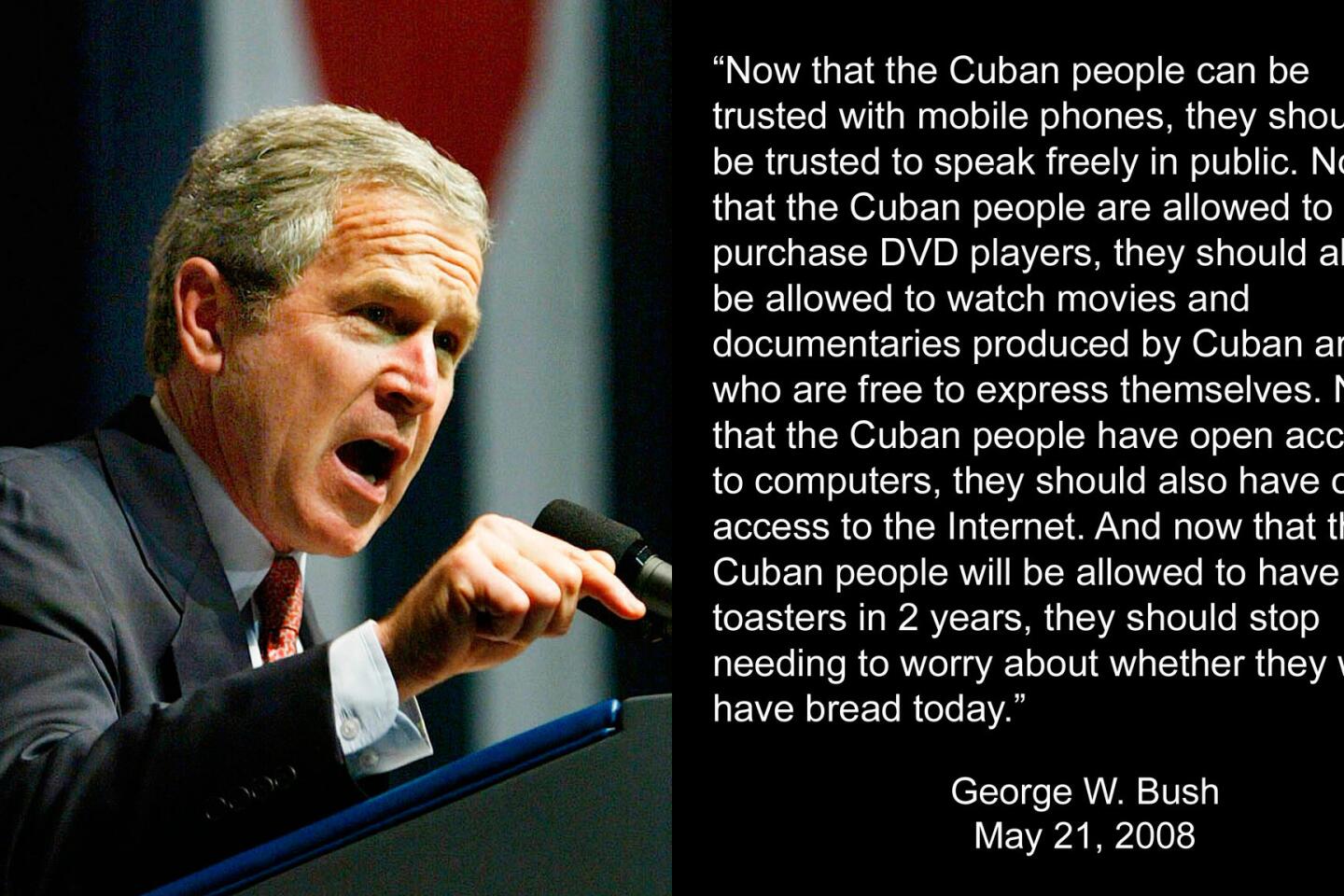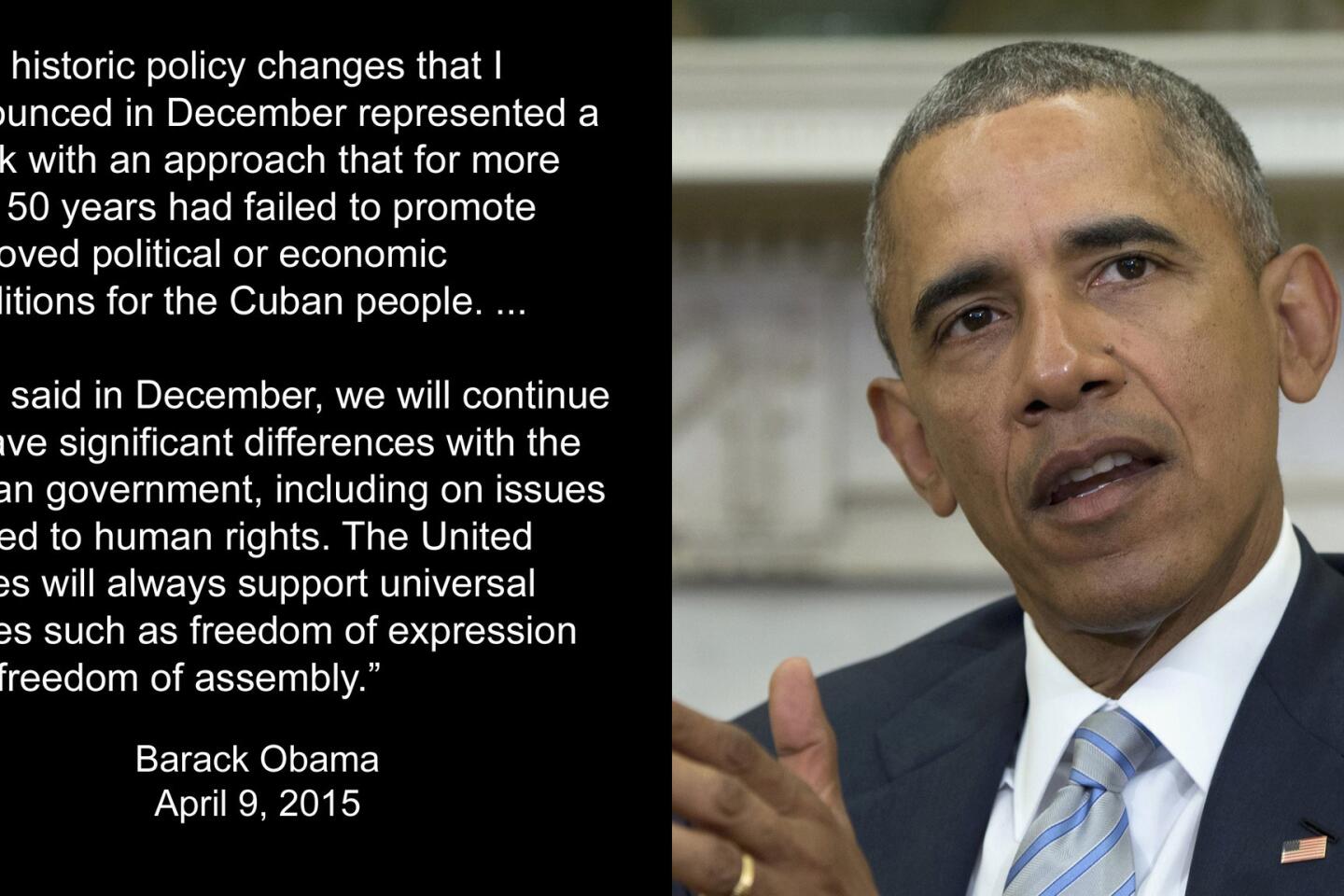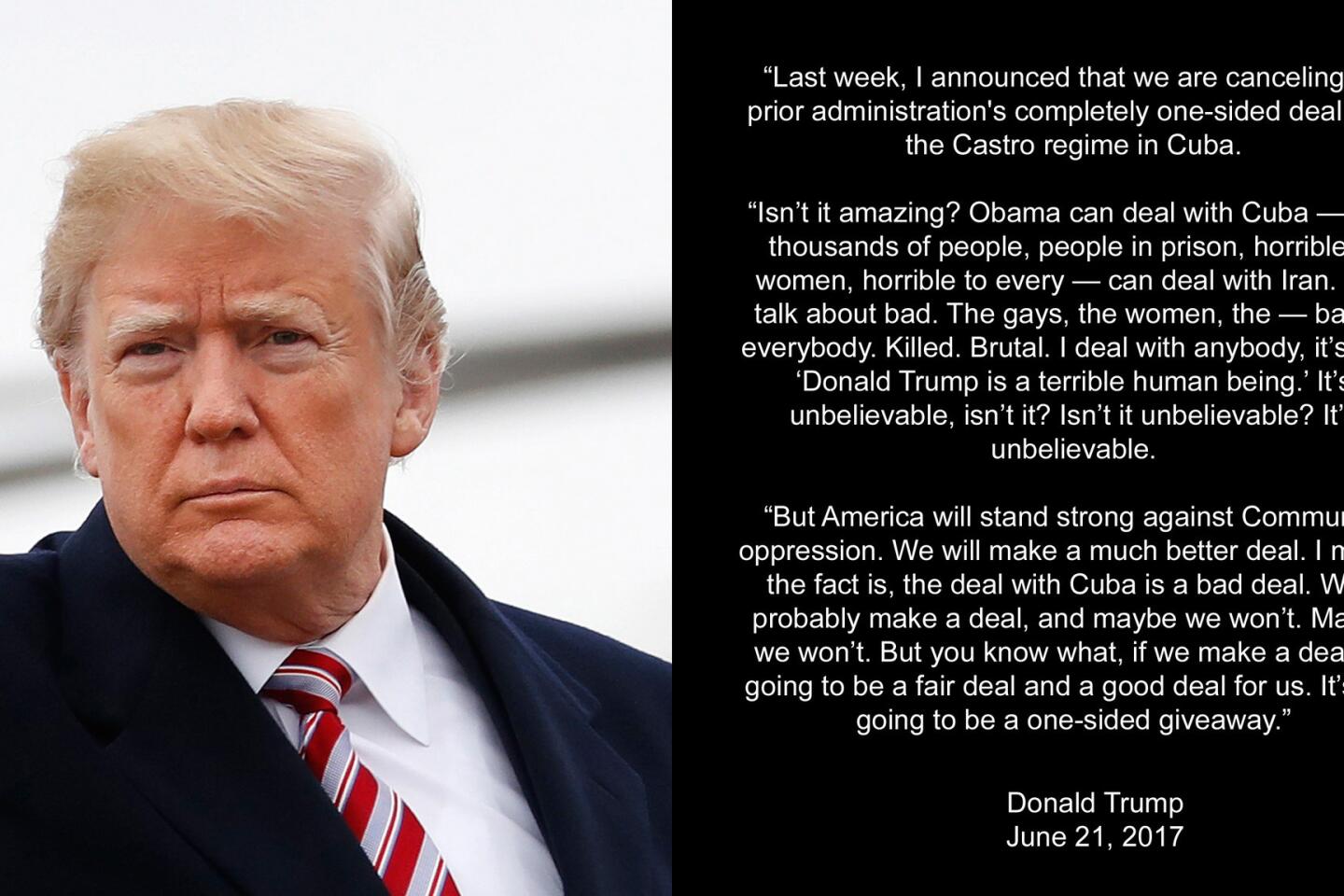For generations, Cuba’s Fidel and Raul Castro vexed U.S. presidents
For the White House, the conundrum of Cuba began in 1959, when a six-year revolution led by Fidel Castro and Che Guevara finally convinced Cuba’s president and despotic ruler Fulgencio Batista it was time to pack a bag and flee.
Decade after decade the Castro brothers — Fidel and Raul — held onto power on the communist island. In that time, 11 U.S. presidents came and went — and a 12th is occupying the Oval Office this week, when Raul Castro finally stepped aside as the country’s ruler.
With the aid of the superb electronic collection called the American Presidency Project at UC Santa Barbara, here are memorable highlights about interactions between a dozen presidencies and one small Caribbean island:
Dwight D. Eisenhower
A year after Batista fled Cuba, Eisenhower was asked about Castro’s Marxist-Leninist beliefs and what to expect from a suddenly unfriendly nation 90 miles away. At first, he opted to be diplomatic. “I’ll just say this,” the president responded. “I am certain this government and all the American people hope that his government will be truly representative of the Cuban people, and that his government will achieve the ability to reflect their views, their aspirations, and to encourage and help their progress.”
Three months later, after Castro challenged the U.S. on trade issues and its capitalist policies, an irritated Eisenhower said: “You would think they would want good relationships. I don't know exactly what the difficulty is.”
By January 1960, a year into the Castro takeover, the president was asked again whether he was going to do anything about the dictator. “We are concerned,” Eisenhower said, “and, more than that, we are perplexed.” Later presidents would understand.
John F. Kennedy
Secretly, with Kennedy’s approval, the Central Intelligence Agency financed and trained an exile force of 1,500 Cuban mercenaries — called Brigade 2506 — to retake Cuba from the communists. The result was the botched Bay of Pigs invasion of April 17, 1961. More than 100 invaders were killed by Castro’s forces at the coastal inlet, with almost 1,100 taken as prisoners. (They were later handed back to the U.S. in a swap for $50 million in food and medicine.)
At a news conference just a few weeks before the invasion, Kennedy was asked, “Is it your view that Fidel Castro is personally a communist?”
He replied, “I would not want to characterize Mr. Castro except to say that by his own words he has indicated his hostility to democratic rule in this hemisphere, to democratic liberal leaders in many of the countries of the hemisphere who are attempting to improve the life of their people, and has associated himself most intimately with the Sino-Soviet bloc, and has indicated his desire to spread the influence of that bloc throughout this hemisphere.”
Lyndon B. Johnson
Following Kennedy’s 1963 assassination by Lee Harvey Oswald, Johnson was quick to strike a Kennedyesque stance on Cuba.
“We have to live on the same planet with the Soviet Union, but we do not have to accept Communist subversion in this hemisphere — or indeed in any free country that can use our help effectively,” he said about two weeks after the shooting. “But especially in this hemisphere I think we should let no day pass without asking what more can we do against Communist subversion and against subversion of the Castro government in particular.”
Richard Nixon
Nixon didn’t spend a lot of time focusing on Cuba, but when he did speak of it he sounded like his predecessors. “As long as Castro is adopting an antagonistic, anti-American line, we are certainly not going to normalize our relations with Castro,” he said in 1971. “As soon as he changes his line toward us, we might consider it. But it is his move.”
A year later, in the midst of an expanding Vietnam War, Watergate and rising talk of impeachment, a reporter asked: “Mr. President, sir, you have sort of a pattern of making peace with enemies around the world. Are you next going to see Fidel Castro?”
“No,” Nixon said. “I have not been invited.”
End of Cuba questions.
Gerald Ford
Though he did push for a 1976 speed-up of immigration by Cubans hoping to enter the U.S., Ford took a similar Nixon approach to Cuba. Recounting a discussion about Cuba with international officials in 1974, he said, “I indicated that we had not seen any change in the attitude of Mr. Castro or any of the other individuals in the Cuban government, and inasmuch as there had been no change, no attitude that was different regarding the United States, it was not expected that our attitude would change toward Cuba.”
Jimmy Carter
When asked about a 1,500-member brigade the Soviet Union maintained in Cuba, Carter said its presence was unacceptable. He said the brigade served no practical military purpose so was probably stationed in Cuba for another reason:
“The brigade has no offensive capability that could threaten us. It has no missiles that could reach our shores. It has no ships or amphibious forces that could launch an attack against the United States. It has no airplanes, nothing that could reach us. It's there primarily, I believe, for two reasons.
“One is to make sure that Castro, who receives several million dollars worth of aid from the Soviet Union every day, is watched by the Soviets in Cuba. And secondly, I think it's there, maybe from the beginning of Castro’s administration, his regime, to support Castro if his people started to turn against him.”
Ronald Reagan
The 40th president wasn’t shy about forcefully denouncing Castro’s government, but he also made Cuba a regular target of cutting humor.
At various stops on his 1984 reelection bid, he noted that his Democratic opponent, former Vice President Walter Mondale, “failed to repudiate the Rev. Jesse Jackson when Jesse Jackson went to Havana, stood with Fidel Castro and said, ‘Long live President Fidel Castro and Che Guevara!’”
That always won boos from the audience.
He also once told a gathering of Cuban Americans they should urge Congress to provide funds, tax relief and other perks to Castro’s opponents, including arms to Cuba’s neighbors for self-defense.
This led to another Cuba joke: “You know, they say there are only two places where communism works: in heaven, where they don't need it — and in hell, where they've already got it.” That remark got laughs.
George H.W. Bush, Bill Clinton and George W. Bush
As Fidel Castro aged and fell into poor health, the next three presidents kept tabs on Cuba but had little direct involvement, other than to remind Castro what they thought of his government. As George W. Bush put it at the start of 2009, “As much of the world celebrates the dawning of a new year, Cuba marks 50 years of one of the cruelest dictatorships this hemisphere has witnessed.”
Castro’s failing health finally forced him to hand over power to Raul in 2006.
Barack Obama
In 2015, Obama and Raul Castro met at the Summit of the Americas in Panama and pledged to restore diplomatic ties and break from the nations’ Cold War past. It was the first time the leaders of the two countries had met in more than half a century.
The following year, Obama visited Havana, and though he and Raul Castro acknowledged the countries remained divided on political issues, they cited many areas of accord, such as ocean conversation, drug interdiction and commercial projects.
“Cuba’s destiny will not be decided by the United States or any other nation,” Obama said.
Donald Trump
In 2017, a year after Fidel Castro’s death, the 45th president promised further trade and economic crackdowns on Cuba.
“Last year, I promised to be a voice against repression in our region — remember, tremendous repression — and a voice for the freedom of the Cuban people,” Trump told a crowd. “You heard that pledge. You exercised the right you have to vote. You went out and you voted. And here I am like I promised. Like I promised. I promise you, I keep my promises. Sometimes, in politics, they take a little bit longer, but we get there. We get there. Don't we get there?”
The audience chanted, “Four more years! Four more years! Four more years!”
Anderson is a special correspondent.
Sign up for Essential California
The most important California stories and recommendations in your inbox every morning.
You may occasionally receive promotional content from the Los Angeles Times.
